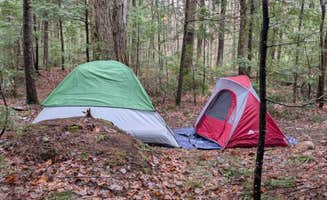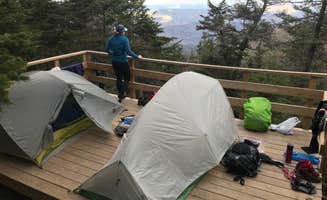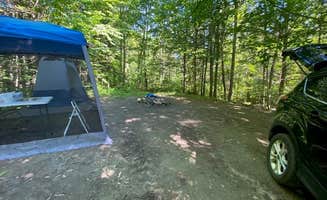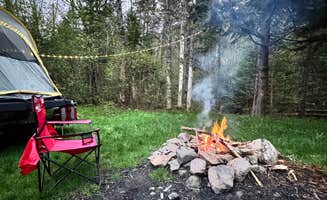Dispersed camping near Freedom, New Hampshire offers numerous primitive sites within the White Mountain National Forest. Seasonal road access typically runs from late spring through early fall, with elevations ranging from 800 to over 4,000 feet in backpacking areas. Campsites vary from roadside pull-offs to established areas with fire rings, with most requiring self-sufficiency for water and waste management.
What to do
Water activities at Town Hall Road: Find sites with river access for cooling off during summer months. As one camper noted, "There are trout in the river and if you cross and go through the woods to the right there's some great spots to explore further!"
Hiking from primitive bases: Tripoli Road serves as an excellent launch point for serious hiking. A visitor mentioned, "This is a great spot to start getting into camping with less amenities and more outdoors. Great hiking trails directly off Tripoli. Hiking the loop trail is amazing."
Swimming holes near Haystack Road: Finish a day of hiking with a refreshing dip. According to a camper, "The road ends at the Little River, offering fishing and swimming options. The parking lot at the end of Haystack Rd serves as the Twin Mountain trail head."
Wildlife observation: Early mornings offer the best wildlife viewing opportunities. Campers frequently report moose and bear sightings, especially near water sources. Keep cameras ready but maintain safe distances from all wildlife.
What campers like
Privacy between sites: The spacing between sites at many dispersed camping areas provides a sense of solitude. At Cherry Mountain Road, one camper observed, "The camp sites are all disbursed enough that we did not hear any other camping sounds at all. It was so quiet I could hear the sound of crow wings flapping as they flew by."
Night sky viewing: Clear mountain nights offer exceptional stargazing at higher elevations. A camper at White Mountains Camping on Little Larry Road shared, "We enjoyed a spectacular view of the Blood Super Moon from the campsite. Overall the site was open to the sky near the road yet protected from the wind."
Stream-side camping: Several sites feature water access for ambient sound and practical uses. One Town Hall Road camper described their experience: "Down toward the river there was plenty of open space so we pitched there and built a fire pit. It was one of our favorite camp spots yet! Very peaceful, beautiful and quiet."
Natural settings with minimal development: The rustic nature of these sites appeals to those seeking an authentic outdoor experience without crowds or facilities. Sites maintain their natural character with minimal clearing.
What you should know
Road conditions and clearances: Many access roads require appropriate vehicles. At Elbow Pond Road, a visitor warned, "The road in is pretty rough and is not recommended for sedans or lower riding cars. Overall this is a great place to camp if you're looking for free camping spots."
Bear safety protocols: Bears frequent these areas, requiring proper food storage. One camper noted, "You need to be aware that bears are in the area. Wildlife like bear and moose will visit you at night. it's almost a certainty, keep your food locked in a bear tight container."
Cell service limitations: Connectivity varies significantly by location and carrier. A Tripoli Road visitor reported, "Cell service is decent at nearby Russell Pond (Verizon seemed to offer better service than AT&T)."
Self-registration requirements: Most sites require completing registration forms at trailheads or ranger stations. Keep cash available for fees, which typically range from $20-30 depending on weekday or weekend stays.
Weather preparedness: Mountain weather changes rapidly, with temperature swings of 30+ degrees possible in a single day, even in summer. Pack layers regardless of forecast.
Tips for camping with families
Site selection for children: Choose sites with natural features that engage kids. At White Mountains Camping on Little Larry Road, a visitor recommended, "These campsites are located on a dead end dirt road. The site at the very top of the road is huge and has a nice stream but if you are camping at any of the other sites, you don't have water flowing by."
Easy access locations: For families with small children, consider locations closer to main roads. "Camp a little further in and you'd be fine," suggested a Tripoli Road camper, noting that sites deeper along roads typically offer better experiences while maintaining reasonable access.
Arrival timing with kids: Plan to arrive with several daylight hours remaining for setup. A Town Hall Road camper advised, "We followed directions exactly as listed below. It does take about 10 minutes to reach the campsites but it's so worth it."
Sites with natural boundaries: Look for sites with natural features like rocks or streams that create contained play areas for children. These boundaries help define the camping area for younger kids.
Backup options: Always have an alternative site in mind when traveling with families, as first-choice locations fill quickly during peak seasons, especially Thursday through Sunday.
Tips from RVers
Size-appropriate site selection: Small to medium trailers can access some dispersed sites while larger rigs cannot. A Town Hall Road reviewer stated, "The road was not as bad as I anticipated. There was room for my Jeep Grand Cherokee towing a squaredrop camper to pass the very few oncoming vehicles we encountered."
Solar considerations for boondocking: Hogan Road Pulloff offers options for those requiring solar power. "Amazing lil spot, a pull off the wild rocky road. very private. right next to a serene view of the lake," noted one camper who found adequate sun exposure.
Leveling challenges: Most sites require significant leveling equipment. According to a Town Hall Road camper, "If all we needed was a campsite with no solar or starlink, this would be 5 star review. Lots of options, great hiking in the area. But if you need solar or starlink, there's only 1 or 2 viable spots."
Water access planning: No dispersed sites offer hookups, requiring self-contained water systems or filtration equipment. Plan for 1-2 gallons per person per day minimum.









